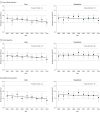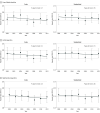Trends in Relative Incidence and Prevalence of Dementia Across Non-Hispanic Black and White Individuals in the United States, 2000-2016
- PMID: 33252617
- PMCID: PMC7953306
- DOI: 10.1001/jamaneurol.2020.4471
Trends in Relative Incidence and Prevalence of Dementia Across Non-Hispanic Black and White Individuals in the United States, 2000-2016
Abstract
Importance: In the US, dementia risk is higher in non-Hispanic Black individuals than in non-Hispanic White individuals. To evaluate progress toward reducing such disparities, tracking secular trends in racial disparities in dementia prevalence is essential.
Objective: To examine whether relative racial disparities in dementia prevalence or incidence have changed in the US from 2000 to 2016.
Design, settings, and participants: The Health and Retirement Study (HRS) is a nationally representative study of adults 50 years or older. New participants are recruited every 6 years, and study visits occur biennially. Approximately 17 000 to 22 000 respondents have been surveyed at each wave since 2000, achieving response rates of 81% to 89%. Data for this cohort study were obtained from non-Hispanic White and non-Hispanic Black participants aged 70 years and older from the 2000 to 2016 waves. For analyses of secular trends in racial disparities in dementia prevalence, each HRS wave was considered separately (range of participants meeting eligibility criteria in each wave, 6322-7579). For analyses of secular trends in racial disparities in dementia incidence, 7 subcohorts were created (range of participants meeting eligibility criteria in each subcohort, 5322-5961) following up people without dementia for 4 years from subcohort baseline visits in 2000, 2002, 2004, 2006, 2008, 2010, and 2012. Data were analyzed from October 2019 to August 2020.
Exposures: Race based on self-response to closed-ended survey questions.
Main outcomes and measures: Dementia status was determined using 3 algorithms with similar sensitivity and specificity across non-Hispanic White and Black participants. Disparities were characterized using ratio measures.
Results: In this study, the mean age and percentage of male participants eligible for inclusion in analyses of racial disparities in dementia prevalence increased over time among non-Hispanic White participants (from 78.2 years and 40% in 2000 to 78.7 years and 44% in 2016) but remained steady in non-Hispanic Black participants during the same period (from 78.0 years and 37% in 2000 to 77.9 years and 38% in 2016). Prevalence ratios comparing Black and White participants ranged from approximately 1.5 to 1.9 across algorithms and years, whereas hazard ratios ranged from approximately 1.4 to 1.8. Although results suggest stable or declining dementia risk overall, there was no evidence suggesting change in relative racial disparities in dementia prevalence or incidence during follow-up.
Conclusions and relevance: This study did not find evidence to suggest that the ratio of dementia risk across Black and White individuals changed in the US between 2000 and 2016. Additional efforts to identify and mitigate the source of these disparities is warranted.
Conflict of interest statement
Figures


Comment in
-
Sankofa-Highlighting Legacy in the Pursuit of Equity for Dementia Science.JAMA Neurol. 2021 Mar 1;78(3):271-272. doi: 10.1001/jamaneurol.2020.4481. JAMA Neurol. 2021. PMID: 33252649 No abstract available.
References
Publication types
MeSH terms
Grants and funding
LinkOut - more resources
Full Text Sources
Other Literature Sources
Medical

